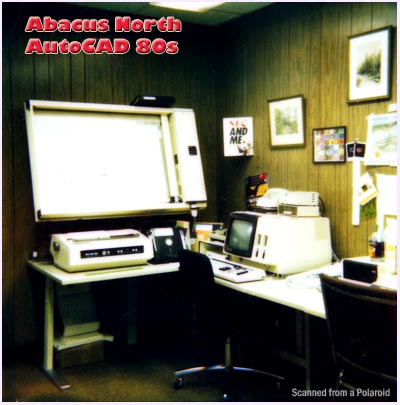Abacus North: A Brief History
The Midlife Crisis
My head spins trying to remember all the details, and I surely will not succeed. I hope if anyone reads this and can add details that they will write and jog my memory. This is a work in progress as I dig through my mind, boxes, film strips and slides. Most of our business documents went through the shredder to protect the personal information in them from identity thieves. I saved a few choice invoices, but not much.
We did a bit of business with AutoCAD bundled with the NEC APC, the best combination for a reasonably priced design and drafting system for architects and engineers at this time. Large plotters for output and Hitachi tablets for input were sold as accessories. All that dried up when we had a construction slump at just the time when Autodesk demanded we add an engineer or architect to our staff and stock an expensive inventory of AutoCAD software, if we wished to continue to remain authorized. We felt we had to drop it. That hurt! We had invested a lot of time and money in AutoCAD training and I enjoyed our contacts with the local engineers and architects, and working with the software. We drafted all our own plans for our new location's interior and wiring using AutoCAD and the big NEC.

NEC APC with Plotter and NEC Spinwriter - Our AutoCAD Room.
Kaypro was a big money maker along with Epson as we start the middle years. A confusing string of models: Kaypro II, 2X, Robie (aka Darth Vader's Lunchbox), IV, 10 all running CP/M. Kaypro followed the CP/M machines with MS-DOS models including the 2000 laptop (aka Darth Vader's laptop) with its early LCD panel—sure to strain even Superman's eyes. Then came the desktops for MS-DOS—Kaypro PC, 286i, and 386. These were pretty good but too late to give Compaq any real strain.
Epson went beyond printers in a big way with the first laptop, the HX-20. It was a hit with Alaska's fish and game people who could run their BASIC programs for collecting data on wildlife for up to 50 hours before needing to recharge. At less than four pounds it suited the backpacking crowd. A well designed harbinger of things to come, it had a tiny screen and printer built in.
Epson's 1983 entry into the desktop market was the QX-10 and a special set of software called Valdocs (short for Valuable Documents). The QX-10 was unlike anything else on the market; the screen was easier to read; the Valdocs software was a step forward in user interface design; and it had our first WYSIWYG (What You See is What You Get) word processor. Competing computers used big clunky full height 5.25" floppy drives and this had a pair of 1/3 height drives that allowed for a slim attractive case.
Eventually the Mac would beat it on user interface and the PCs would gather the software support to capture business customers. Epson followed the QX-10 with a QX-16 before dropping Valdocs and going strictly PC compatible from 1985 through the early 90s with their Equity line of solidly built and well supported machines—the Equity I, Equity Ie, Equity I+, Equity II, Equity III, Equity III+, Equity LT, Equity 286, Equity 386SX and the Equity 386DX.
I took a real flyer when a company in Colorado, General Robotics Corporation, introduced the first "personal robot", the RB5X. Thinking that this might catch on, especially with schools, we brought the president of the company to Alaska to make a presentation to some local educators. Rodger Ellis joined us in programming the beast and we showed it around a bit. There were no takers, a concept ahead of its time, but the company, under the third owner, is still in business, barely. The product was actually solid and it has had a small but loyal fan base. Someday this will take off, without me! At least friend Rodger landed a contract to design the plug in board to provide speech to RB, an option still listed on the RB Robotics web site.
At the end of this period Costco and lots of mail order houses were selling computers to home and office users and computers became a low margin commodity, and we knew we must move to service and support.



